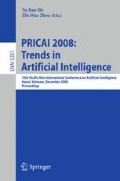Abstract
We present a novel method to obtain high quality skeletons of binary shapes. The obtained skeletons are connected and one pixel thick. They do not require any pruning or any other post-processing. The computation is composed of two major parts. First, a small set of salient contour points is computed. We use Discrete Curve Evolution, but any other robust method could be used. Second, particle filters are used to obtain the skeleton. The main idea is that the particles walk along the skeletal paths between pairs of the salient points. We provide experimental results that clearly demonstrate that the proposed method significantly outperforms other well-known methods for skeleton computation.
Access this chapter
Tax calculation will be finalised at checkout
Purchases are for personal use only
Preview
Unable to display preview. Download preview PDF.
References
Blum, H.: Biological shape and visual science (part i). J. Theoretical Biology 38, 205–287 (1973)
Siddiqi, K., Shkoufandeh, A., Dickinson, S., Zucker, S.: Shock graphs and shape matching. In: ICCV, pp. 222–229 (1998)
Zhu, S., Yuille, A.: Forms: a flexible object recognition and modeling system. In: ICCV (1995)
Sebastian, T.B., Klein, P.N., Kimia, B.B.: Recognition of shapes by editing their shock graphs. IEEE Trans. PAMI 26, 550–571 (2004)
Macrini, D., Siddiqi, K., Dickinson, S.: From skeletons to bone graphs: Medial abstraction for object recognition. In: CVPR (2008)
Bai, X., Latecki, L.J.: Path similarity skeleton graph matching. IEEE Trans. PAMI 30, 1282–1292 (2008)
Bai, X., Latecki, L.J., Liu, W.Y.: Skeleton pruning by contour partitioning with discrete curve evolution. IEEE Trans. PAMI 29, 449–462 (2007)
Bai, X., Yang, X.W., Yu, D.G., Latecki, L.J.: Skeleton-based shape classification using path similarity. Int. Journal of Pattern Recog. and Artif. Intell. 22, 733–746 (2008)
Ogniewicz, R.L., Kübler, O.: Hierarchic voronoi skeletons. Pattern Recognition 28, 343–359 (1995)
Shaked, D., Bruckstein, A.M.: Pruning medial axes. CVIU 69, 156–169 (1998)
Choi, W.P., Lam, K.M., Siu, W.C.: Extraction of the euclidean skeleton based on a connectivity criterion. Pattern Recognition 36, 721–729 (2003)
Bai, X., Latecki, L.J.: Discrete skeleton evolution. In: Yuille, A.L., Zhu, S.-C., Cremers, D., Wang, Y. (eds.) EMMCVPR 2007. LNCS, vol. 4679, pp. 362–374. Springer, Heidelberg (2007)
Adluru, N., Latecki, L.J., Lakämper, R., Young, T., Bai, X., Gross, A.: Contour grouping based on local symmetry. In: ICCV (2007)
Latecki, L.J., Lakämper, R.: Shape similarity measure based on correspondence of visual parts. IEEE Trans. PAMI 22, 1185–1190 (2000)
Isard, M., Blake, A.: Contour tracking by stochastic propagation of conditional density. In: ECCV, pp. 343–356 (1998)
Isard, M., Blake, A.: Condensation – conditional density propagation for visual tracking. IJCV 29, 5–28 (1998)
Black, M.J., Fleet, D.J.: Probabilistic detection and tracking of motion boundaries. IJCV 38, 231–245 (2000)
Pérez, P., Blake, A., Gangnet, M.: Jetstream: Probabilistic contour extraction with particles. In: ICCV (2001)
Isard, M.: Pampas: Real-valued graphical models for computer vision. In: CVPR, pp. 613–620 (2003)
Sudderth, E.B., Ihler, A.T., Freeman, W.T., Willsky, A.S.: Nonparametric belief propagation. In: CVPR, pp. 605–612 (2003)
Doucet, A., de Freitas, N., Gordon, N.: Sequential Monte Carlo Methods in Practice. Springer, New York (2001)
Gordon, N.J., Salmond, D.J., Smith, A.F.M.: Novel approach to nonlinear/non-gaussian bayesian state estimation. IEE Proceedings-F 140, 107–113 (1993)
Golland, P., Grimson, E.: Fixed topology skeletons. In: CVPR (2000)
Author information
Authors and Affiliations
Editor information
Editors and Affiliations
Rights and permissions
Copyright information
© 2008 Springer-Verlag Berlin Heidelberg
About this paper
Cite this paper
Bai, X., Yang, X., Latecki, L.J., Xu, Y., Liu, W. (2008). Computing Stable Skeletons with Particle Filters. In: Ho, TB., Zhou, ZH. (eds) PRICAI 2008: Trends in Artificial Intelligence. PRICAI 2008. Lecture Notes in Computer Science(), vol 5351. Springer, Berlin, Heidelberg. https://doi.org/10.1007/978-3-540-89197-0_7
Download citation
DOI: https://doi.org/10.1007/978-3-540-89197-0_7
Publisher Name: Springer, Berlin, Heidelberg
Print ISBN: 978-3-540-89196-3
Online ISBN: 978-3-540-89197-0
eBook Packages: Computer ScienceComputer Science (R0)

